INTRODUCTION
Cananga odorata (Lam.) Hook. f. and Thomson, commonly known as ylang-ylang or perfume tree, is an evergreen perennial tropical tree (as shown in Figure 1) belonging to the Annonaceae family which natively grows in Malaysia, the Philippines, Indonesia, the Islands of Madagascar, the Comoro, and Nossi Be and has been widely used for various purposes such as cosmetics, food industry, medication, and agriculture [1]. The botanical synonyms are as follows: C. odoratum (Lam.) Baill. ex King; C. odoratum (Lam.) Baill. ex King; Unona odorata (Lam.) Baill.; U. odorata (Lam.) Dunal; Uvaria gaertneri DC.; Uvaria javanica Thunb.; Uvaria odorata Lam [2]. While C. odorata is taxonomically classified as follows: Plantae (kingdom), Angiosperms (plant division), Magnoliopside (class), Magnoliales (order), Annonaceae (family), Cananga (Dunal) Hool. f. and Thomson (genus), and C. odorata (lam.) Hook. f. and Thomson (species) [1]. The extraordinary essential oil content of the flowers makes this plant widely cultivated for commercial purposes [3]. The community’s cultivation of C. odorata is confined to preserving plant seeds that develop naturally around the parent tree [4]. This may have an impact on the availability of these plants in nature. Apart from that, many environmental aspects have been reported to impact its growth and sustainability. Water, soil nutrients, and temperature pressure impact plant growth and the development of secondary metabolites in diverse plants [5–7]. Overharvesting due to human needs and plant product commercialization without balanced cultivation efforts are also detrimental to plant longevity [8].
Studies related to this plant were first published in Scopus in 1975, which reported the presence of hexylene glycol content in commercial volatile oils of C. odorata [9]. Cananga odorata mostly contains linalool, germacrene D, and β-caryophyllene as secondary metabolites with a chemical structure as shown in Figure 2. Linalool is considered to be responsible for the characteristic floral perfume of C. odorata [1].
The pharmacological activities of C. odorata as an antioxidant, repellant, antimicrobe, and antianxiety have been reported [10–14]. Antibiofilm, antidiabetic, antifertility, anti-melanogenesis, sedative, and relaxing effects are also found in C. odorata [1]. Secondary metabolites of medicinal plants have a crucial role in defining their biological actions [15]. Widespread use of C. odorata has traditionally been reported in various regions. Essential flower oil treated respiratory and cardiovascular disorders in North Sumatra [16]. Seeds may be used to treat fever, flowers can be used for traditional ceremonies or cultural rites, and leaves can be used to heal skin diseases and asthma [17]. Essential oil provision of C. odorata flowers with a dose of 30 mg/kg for 28 days showed neuropathic pain alleviation and reduced pain-related anxiety in male mice [18]. In combination with crude extracts of Vetiveria zizanioides and Andrographis paniculata, C. odorata demonstrated synergistic effectiveness as a repellent [12]. The findings of a sub-acute toxicity research conducted in 2023 revealed that administration of an ethanol extract of C. odorata flowers at a concentration of 500 mg/kg bw caused no adverse effects in the histopathology of the test rat’s organs [19].
According to the Indonesia Food and Drug Supervisory Agency’s Decree number 25 of 2023, natural medicines or traditional Indonesian medicines are classified into three categories: Jamu or traditional herbal medicines, standardized herbal medicines, and phytopharmaceuticals. Jamu is a natural medicine derived from traditional knowledge or Indonesian cultural heritage used for health maintenance, health improvement, illness prevention, treatment, or health recovery and more than 95% of jamu consumers recognize and have experienced the benefits of herbal remedies for their health [20,21]. Due to the vast diversity of Indonesian ethnic groups and local cultures, knowledge of traditional remedies in Indonesia is relatively affluent [22]. Each ethnic group has a wealth of information passed down from generation to generation [23]. Based on empirical data, the indigenous knowledge of the effectiveness of many medicinal plants has been demonstrated to be beneficial and safe. Since ancient times, the community has used medicinal plants grown on communal property to acquire traditional medical supplies [24]. Traditional medicine usage has increased throughout time, and various factors underlie this change. Following the Ministry of Health’s national basic health research, traditional medicine use in Indonesia grew by more than 44% from 2010 to 2018 [25]. The usage of traditional medicine was linked with gender, residence, age, marital status, and distance to health services [26]. Sundararajan observed that poverty is one of the significant variables affecting the desire to utilize traditional medicine in Mwanza, Tanzania [27]. Apart from price and accessibility, the type and ability of treatment possessed by healers also influence the preference of traditional medicine use [28]. Having few side effects is also a consideration when using traditional medicine [29].
The practice of employing traditional medicine is one of the indigenous traditions of Indonesian society. Indigenous cultures have traditionally created, developed, and passed down knowledge orally without any documentation over the generations. This unrecorded indigenous knowledge and expertise, inappropriate harvesting methods, commercial utilization, and extensive industrialization are all issues threatening the survival of traditional indigenous medicine [30–32]. Preserving the noble values and wisdom of traditional knowledge, applying traditional knowledge in daily life, documenting the diversity of traditional knowledge, and revitalizing and preserving the cultural ecosystem for any traditional knowledge and inheritance are some efforts to avoid deterioration, loss, or destruction of traditional knowledge [33]. Furthermore, no research has been performed to document the application of C. odorata by traditional healers in various ethnic groups in Indonesia to treat various disease indications. Thus, this study aims to discover and document indigenous traditional knowledge on the use of C. odorata for medical purposes by traditional healers in diverse ethnic groups in Indonesia.
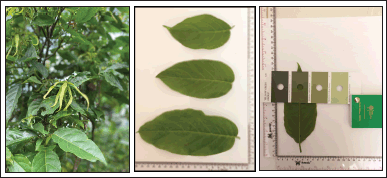 | Figure 1. Original photograph of C. odorata plants, leaves, and leaf color refers to the color categories on the RHS colour chart (growing in Indonesia’s Central Java Province area). [Click here to view] |
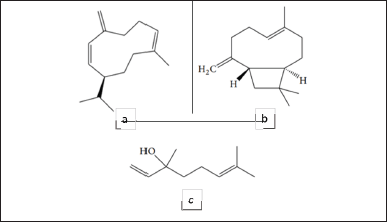 | Figure 2. The chemical structures of the principal secondary metabolites of C. odorata, namely linalool (a), germacrene D (b), and β-caryophyllene (c). [Click here to view] |
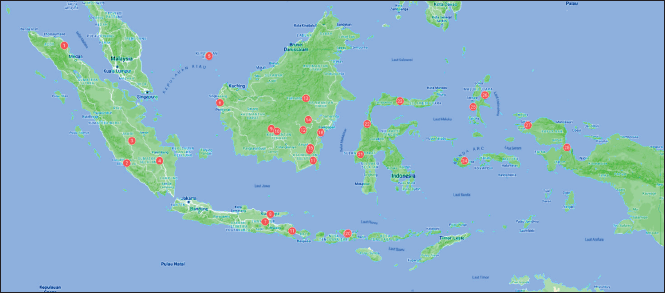 | Figure 3. The location of the study area data is processed with MapSource® Garmin® mapping software). It shows ethnic groups that use C. odorata in concoctions: 1. Tamiang, 2. Lebak, 3. Anak Dalam, 4. Pegagan, 5. Melayu Natuna, 6. Dayak Bentian, 7. Jawa Majapahit, 8. Madura, 9. Dusun Maanyan, 10. Bakumpai, 11. Osing, 12. Dayak Tabuyan, 13. Tunjung, 14. Halok, 15. Ulu Batang Ali, 16. Pitap, 17. Pagatan, 18. Paser, 19. Kore, 20. Dompu, 21. Mamuju, 22. Dampelas, 23. Polahi, 24. Buru/Batabual, 25. Makian, 26. Tugutil, 27, Moi Pedalaman/Maibo, 28. Wamesa. [Click here to view] |
MATERIALS AND METHODS
Study area
The ethnomedicine study area included 254 ethnic groups in 34 provinces of Indonesia. The identification and selection of traditional healers that employ C. odorata for their therapy is carried out according to all the information obtained across all ethnicities. Figure 3 depicts the ethnic group location employed C. odorata for healing diseases, consisting of 28 ethnic groups within 16 provinces in Indonesia.
Data collection
Data collected by the research team corresponds to the earlier publication [34,35]. Each team comprises five researchers with biology, sociology, anthropology, and health backgrounds. A total of five traditional healers on each ethnic group were chosen using a purposive sample approach based on inclusion criteria such as the healer being of native or enculturated ethnicity, having knowledge, ability, and carrying out treatment using medicinal plants, the most effective, well-known and be recognized by the community. Healers having specialized therapeutic competence in one type of ailment were excluded from this study. The researcher obtained initial information regarding the whereabouts of healers from tribal chiefs, community leaders, village offices, and other trustworthy sources. The most well-known and highest patient number was used to determine informants among ethnic groups with more than five healers who met inclusion criteria. Data were gathered through in-depth interviews based on semi-structured questionnaires. The information gathered includes the demographic data of healers, medicinal plants used, potions, and their applications for health purposes. After the interview with the informant, medicinal plant specimens were collected and stored at the Tawangmanguensis Herbarium of Indonesia. The study received ethical approval from the Health Research Ethics Commission, National Institute of Health Research and Development, Ministry of Health of the Republic of Indonesia, with the codes LB.02.01/5.2/KE.318/2015 and LB.02.02/2/KE.107/2017. The data in this article can be accessed from the Health Development Policy Agency Indonesia at www.badankebijakan.kemkes.go.id.
 | Table 1. Demographic information of the selected traditional healers as informants. [Click here to view] |
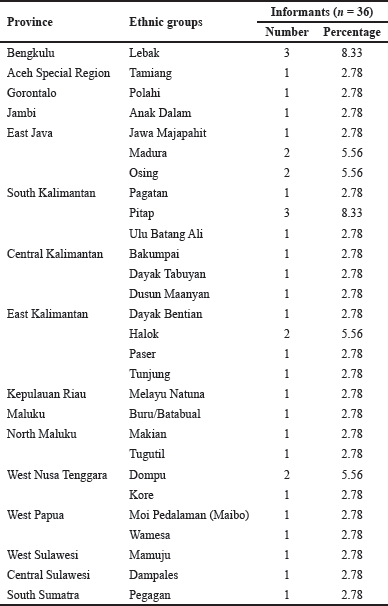 | Table 2. Informants distribution in each ethnic group and province. [Click here to view] |
Data analysis
The traditional healer’s gender, age group, education levels, knowledge sources, and occupation were descriptively analyzed to determine frequencies and proportions. To cure diseases using C. odorata, the source of materials, plant parts, formula composition, and administration techniques used in this study were descriptively examined.
Treatable diseases (hemorrhoid, antidote, sexually transmitted disease, back pain, mental disorder, cough, obesity, fever, cosmetics, rheumatics and gout, wound healing, pre and postpartum care, other internal diseases, hypertension, stomachache, smallpox disease, and skin disease) using C. odorata by thirty-six traditional healers were analyzed with multi health purposes simple ranking exercise referring to previous studies [34,36].
Plant part value (PPV)
PPV was a parameter for calculating the proportion of employed plant parts. The percentage of C. odorata plant organs for medication purposes by traditional healers in ethnic groups of Indonesia was determined by following the formula. PPV is the plant part utilized value, and RU is the quantity of use stated for each plant part [37].
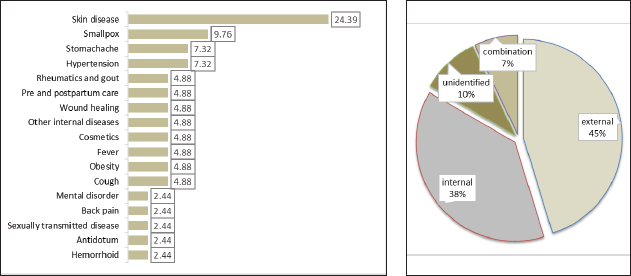 | Figure 4. The percentage of treatable diseases healed by traditional healers using C. odorata (a) and the administration route of C. odorata (b). [Click here to view] |
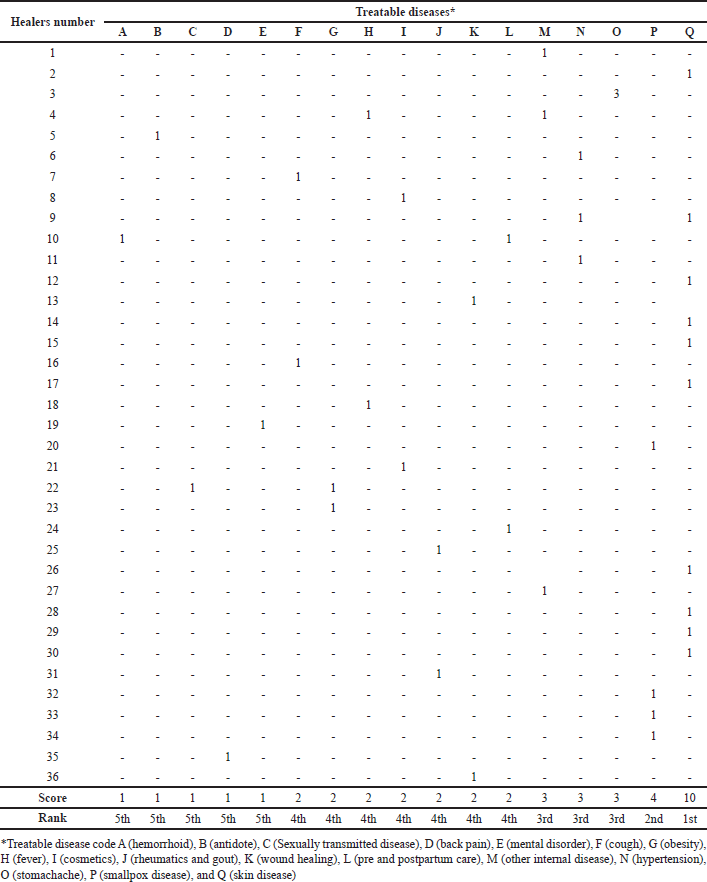 | Table 3. Multihealth purposes simple ranking of seventeen treatable diseases using C. odorata by thirty-six traditional healers. [Click here to view] |
PPV (%) = (ΣRU (plantpart) / ΣRU) × 100
RESULTS
Sociocultural profile of informants
This research included 36 traditional healers from 28 ethnic groups dispersed over 16 Indonesian provinces. Table 1 provides a brief socio-cultural profile of the informants. Almost 70% of healers are men, with the majority being over 59 years old, with a low level of education, their primary employment being farming, and practically all healers gaining traditional knowledge through grandparents and their parents. According to Table 2, the Lebak ethnic group from Bengkulu Province, as well as the Pitap ethnic group from South Kalimantan, had the greatest number of informants who utilized C. odorata for traditional medicine, followed by the Madura and Osing ethnic groups from East Java and the Halok ethnic group from East Kalimantan.
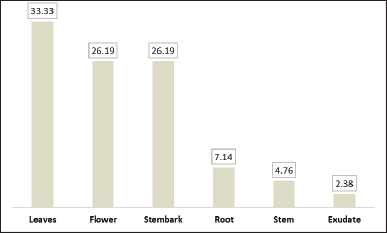 | Figure 5. Plant part utilized by traditional healers. [Click here to view] |
Treatable diseases and administration route
Compared to other ailments, skin disease is a symptom of a medical condition frequently treated by healers leveraging C. odorata, as indicated by a percentage of almost 25%. As shown in Figure 4(a), some of the most uncommon symptoms are hemorrhoids, poisoning, sexual illnesses, back discomfort, and mental issues. Figure 4(b) displayed all three kinds of C. odorata herbs delivery routes advocated by healers, namely internally or orally, externally, and a mix of both. In contrast, the external route was the most prominent provision route, accounting for 45% of the total. Meanwhile, for multihealth purposes, a simple ranking of seventeen treatable diseases (hemorrhoid, antidote, sexually transmitted disease, back pain, mental disorder, cough, obesity, fever, cosmetics, rheumatics and gout, wound healing, pre and postpartum care, other internal diseases, hypertension, stomachache, smallpox disease, and skin disease) using C. odorata by thirty-six traditional healers were revealed on Table 3.
 | Figure 6. Medicinal plant sources (a) and cultivation efforts of C. odorata conducted by healers (b). [Click here to view] |
 | Table 4. Identified chemical composition of C. odorata plant parts. [Click here to view] |
PPV
Cananga odorata plant parts are employed, especially exudate, stem, root, stembark, flower, and leaves. Leaves have been discovered as the most frequently used substance by healers for treatment, shown by a PPV of 33%, as shown in Figure 5.
Medicinal plant sources and cultivation efforts
Traditional healers obtained C. odorata from various places, including riverbanks, gardens, backyards, woodlands, and market purchases. More than 40% of the herbs were gathered by natural harvesting from the forest, followed by home yard, garden, market purchase, and riverfront collection [Fig. 6(a)]. According to the study findings in Figure 6(b), more than 60% of C. odorata gathered and utilized by healers has yet to be attempted to cultivate.
DISCUSSION
This study emphasizes the essential role of traditional healers in sustaining ethnic communities’ health through medicinal plants, particularly C. odorata. The results acknowledged that males represent a larger proportion of healers. This is tied to various perspectives, including that males are responsible for caring for their families, that parents generally pass on their expertise and ability to the sons, and that being in the role of traditional healers elevates men’s prestige in society. This is consistent with reports from Bali, Indonesia, whereby the community acknowledges and honors traditional healers [38]. They are frequently seen as the traditional moral and value code defenders [39]. In Sub-Saharan Africa, most citizens believe traditional healers are their sole choice for meeting healthcare requirements [39]. Even though they practice traditional medicine, healers in Sub-Saharan Africa are already aware of how to protect themselves against disease transmission from patients [40].
In the current study, healers over the age of 58 predominated, and roughly 14% of healers were under the age of 49, with more than 50% having a low level of formal education. Most healers obtained traditional medicine expertise and abilities from their parents (75%) and elders (68%). Inevitably, passing knowledge and treatment abilities is separate from documentation and generally occurs verbally, leaving this crucial knowledge at risk [41,42]. A person’s understanding of traditional medicine increases with age [43]. This study result contradicts prior research, which found that the more a person’s degree of education and understanding, the greater their usage and practice of traditional medicine [44]. Traditional medicine is unappealing to youthful generations in Mali, Africa, which is predicted to affect the future decrease of traditional healers. However, the growing education level offers prospects for collaboration with modern medical practices [45].
The study exhibited that the most significant usage of C. odorata is for treating skin disorders, which occupy the first rank of curable conditions with a score of 10 and a percentage of about 25% compared to other diseases in Indonesian ethnic groups. This relates to the proportion of administration routes since external usage outnumbers internal applications and other ways by 45%. The topical route over the skin is considered an effective technique for alleviating the limitations of other internal routes [46]. Skin diseases are quite prevalent in Indonesia. Itching is the most prevalent sign of a skin illness. Severe itching can degrade one’s quality of life and lead to other health problems [47]. Unhealthy behavior, hygiene, and the surroundings may give rise to the spreading of diseases, particularly skin diseases. Scabies and dermatitis are two of Indonesia’s most prevalent skin-related diseases [48,49]. A lack of awareness of the many skin diseases and how to prevent them leads to someone developing acute skin illness [50]. Moreover, Indonesia is tropical, and air humidity, temperature, and sunlight contribute to skin disease cases [51]. Several investigations have found C. odorata to be antifungal and antibacterial. Cananga odorata stem bark contains the alkaloid liriodenine and sampangine, which inhibit the development of Gram-positive bacteria, yeast, and fungus. Hexane stem bark extract demonstrated efficacy against Candida albicans and Propionibacterium acnes [1,52,53].
As opposed to flower, stembark, root, stem, and exudate, leaves are the component of the C. odorata that healers frequently employ, and it is in tune with the outcomes of several prior investigations. This condition can be attributed to a variety of reasons, such as the plenty availability of plant leaves, the relative ease with which leaf parts can be harvested compared to other parts, collecting in large amounts not lead to plant death or damage, and multiple studies have highlighted several chemical substances (as revealed in Table 4) related to a plant’s pharmacological properties are frequently discovered in the leaves.
The results of this study indicate that over 60% of the C. odorata utilized by healers of various ethnicities in Indonesia has yet to be farmed. Even though C. odorata was included in the minor concern (LC) category according to the results of the International Union for Conservation of Nature and Natural Resources Red List of Threatened Species assessment in 2019; conservation and cultivation efforts are needed to prevent this species category from increasing to the near-threatened (NT) level, which is close to qualifying or assessed to be in the endangered category shortly [54]. The preference of healers for wild harvesting from forests or other places is related to several factors, including the fact that the material is still available in large quantities in nature. Thus, it is easy to obtain, more economical, does not require sacrificing time, space, or costs to plant, and can be taken whenever needed. Aside from these benefits, natural harvesting has several drawbacks, such as uneven plant conditions and inconsistent quality and availability [55]. Meanwhile, medicinal plant cultivation will expand in areas where appropriate technology is accessible, replacements are unavailable, and costs stay considerable [56].
The limitations of this study include the fact that the emphasis of this study is confined to the use of C. odorata by traditional healers from a health perspective alone, and it has not studied its usage from different viewpoints, such as economic and cultural factors from each ethnicity. Aside from that, due to time constraints and other resources, the number of informants chosen based on the inclusion criteria was restricted to five healers per ethnic group. This provides the possibility for untapped local ethnomedicine knowledge possessed by the sixth healers and others in each ethnic group, as well as information and abilities in treatment utilizing medicinal plants owned by indigenous communities other than healers that have yet to be documented. Thus, future ethnomedicine studies focusing on each ethnicity utilizing the snowball sampling approach with a broader range of informants and in-depth information are required.
CONCLUSION
This study emphasized the significant role of traditional healers in healing various illnesses with C. odorata and the variations in C. odorata ethnomedical usage as a traditional remedy in Indonesian ethnic groups. Nonetheless, cultivating initiatives should be started as more than 60% of identified C. odorata has yet to be grown. The study’s findings are likely to benefit various stakeholders, serve as baseline data for further studies on the efficacy and safety of C. odorata, and contribute to efforts for developing health products that employ C. odorata. With diverse information and facts on the traditional usage of C. odorata for health purposes, supported by scientific data on various pharmacological properties and the presence of secondary metabolite substances, C. odorata has considerable potential to be developed as a therapeutic substance.
ACKNOWLEDGMENTS
The authors thank all traditional healers in Indonesia, the Ristoja team, and B2P2TOOT for carrying out Ristoja.
AUTHOR CONTRIBUTIONS
Conceptualization, NR, YW, AR, AE; methodology, NR and RM; software, RM and IY; validation, NR, YW, AR, AE; formal analysis, NR; investigation, NR, YW; resources, NR and RM; data curation, NR; writing original draft preparation, NR, AE, AR, YW; writing, review and editing, NR, AR, AE, YW; visualization, NR; supervision, YW, AE, AR. All authors contributed to editorial changes in the manuscript. All authors read and approved the final manuscript.
FINANCIAL SUPPORT
The Medicinal Plant and Traditional Medicine Research and Development Centre, NIHRD, MoH RI, financed this study with decree number HK.02.03/I/1825/2017.
CONFLICTS OF INTEREST
The authors report no financial or any other conflicts of interest in this work.
ETHICAL APPROVALS
The study protocol was approved by the Health Research Ethics Commission, National Institute of Health Research and Development, Ministry of Health of the Republic of Indonesia, with the approval number LB.02.01/5.2/ KE. 318/2015 and LB.02.02/2/KE.107/2017.
DATA AVAILABILITY
All data generated and analyzed are included in this research article.
USE OF ARTIFICIAL INTELLIGENCE (AI)-ASSISTED TECHNOLOGY
The authors declares that they have not used artificial intelligence (AI)-tools for writing and editing of the manuscript, and no images were manipulated using AI.
PUBLISHER’S NOTE
All claims expressed in this article are solely those of the authors and do not necessarily represent those of the publisher, the editors and the reviewers. This journal remains neutral with regard to jurisdictional claims in published institutional affiliation.
REFERENCES
1. Tan LTH, Lee LH, Yin WF, Chan CK, Abdul Kadir H, Chan KG, et al. Traditional uses, phytochemistry, and bioactivities of Cananga odorata (Ylang-Ylang). Evid-Based Complement Altern Med ECAM. 2015;2015:896314.
2. Cananga odorata (Lam.) Hook.f. & Thomson [Internet]. 2024 [cited 2024 Feb 20]. Available from: https://www.worldfloraonline.org/taxon/wfo-0000583386
3. Kaewpetch T, Pratummang A, Suwarak S, Wongphan P, Promhuad K, Leelaphiwat P, et al. Ylang-ylang (Cananga odorata) essential oils with flora odorants enhanced active function of biodegradable polyester films produced by extrusion. Food Biosci. 2023 Feb;51:102284.
4. Propantoko H, Mansur I, Wulandari AS. Study of cultivation traditional technical and production Java Kenanga (Cananga odorata f. macrophylla) in Blitar. J Trop Silviculture. 2020;11(3):177–82.
5. Laftouhi A, Eloutassi N, Ech-Chihbi E, Rais Z, Abdellaoui A, Taleb A, et al. The impact of environmental stress on the secondary metabolites and the chemical compositions of the essential oils from some medicinal plants used as food supplements. Sustainability. 2023 May 10;15(10):7842.
6. Pant P, Pandey S, Dall’Acqua S. The influence of environmental conditions on secondary metabolites in medicinal plants: a literature review. Chem Biodivers. 2021 Nov;18(11):e2100345.
7. Ncube B, Finnie JF, Van Staden J. Quality from the field: the impact of environmental factors as quality determinants in medicinal plants. South Afr J Bot. 2012 Sep;82:11–20.
8. Wangchuk P, Olsen A. Risk factors for the sustainability of medicinal plants in Bhutan. Asian Med. 2010;6(1):123–36.
9. Peyron L, Acchiardi J, Pellerin P. Abnormal presence of hexylene glycol in commercial volatile oils of Vetiveria zizanoides and Cananga odorata. Plantes Med Phytother. 1975;9(3):192–203.
10. Mallavarapu GR, Gurudutt KN, Syamasundar KV. Ylang–Ylang (Cananga odorata) oils. In: Essential oils in food preservation, flavor and safety [Internet]. Elsevier;2016 [cited 2024 Feb 20]:865–73. Available from: https://linkinghub.elsevier.com/retrieve/pii/B9780124166417000997
11. Khe Jiea C, Fuloria S, Subrimanyan V, Sekar M, V. Sathasivam K, Kayarohanam S, et al. Phytochemical screening and antioxidant activity of Cananga odorata extract. Res J Pharm Technol. 2022 Mar 24;1230–4.
12. Panthawong A, Nararak J, Jhaiaun P, Sukkanon C, Chareonviriyaphap T. Synergistic behavioral response effect of mixtures of Andrographis paniculata, Cananga odorata, and Vetiveria zizanioides against Aedes aegypti (Diptera: Culicidae). Insects. 2023 Feb 3;14(2):155.
13. Niaci S. Phytochemical properties of methanol and ethyl acetate extracts of Cananga odorata flowers and their pharmacological activities. J Med Pharm Allied Sci. 2021 Nov 15;10(6):3874–7.
14. Zhang N, Wang ST, Yao L. Inhalation of Cananga odorata essential oil relieves anxiety behaviors in autism-like rats via regulation of serotonin and dopamine metabolism. J Integr Med. 2023 Mar;21(2):205–14.
15. Sholikhah EN. Indonesian medicinal plants as sources of secondary metabolites for pharmaceutical industry. J Thee Med Sci Berk Ilmu Kedokt. 2016 Nov 10;48(04):226–39.
16. Aswandi A, Kholibrina CR. Ethnomedicine of forest’s essential oils for respiratory and cardiovascular treatments in Northern Sumatra. In: IOP Conference Series: Earth and Environmental Science. 2021;012073.
17. Putri AM, Muham AO, Anggraini S, Maisarmah S, Yulis PAR. Analisis kualitatif kandungan bunga kenanga (Cananga odorata) secara fitokimia dengan menggunakan pelarut etanol. J Res Educ Chem. 2020 May 28;2(1):43.
18. Borgonetti V, López V, Galeotti N. Ylang-ylang (Cananga odorata (Lam.) Hook. f. & Thomson) essential oil reduced neuropathic-pain and associated anxiety symptoms in mice. J Ethnopharmacol. 2022 Aug;294:115362.
19. Mani S, Ganie RA, Sari DK, Sari LM, Rachmawati M, Muhamad N. Subacute toxicity yellow flower extract (Cananga odorata) on histopathology of white rat heart (Rattus norvegicus). Sumat Med J. 2023 May 15;6(2):46–52.
20. Adiyasa MR, Meiyanti M. Pemanfaatan obat tradisional di Indonesia: distribusi dan faktor demografis yang berpengaruh. J Biomedika Dan Kesehat. 2021 Sep 30;4(3):130–8.
21. Obat BP, Indonesia MR. Peraturan Badan Pengawas Obat Dan Makanan nomor 25 tahun 2023 tentang kriteria dan tata laksana registrasi obat bahan alam. 2023.
22. Soedarsono R, Sangat-Roemantyo H. Jamu as traditional medicine in Java, Indonesia. S Pac Study. 2002;23(1):1–10.
23. Handayani H. Traditional to rational and modern phytopharmaca. In: Proceeding of Surabaya International Health Conference. Surabaya; 2017.
24. Sumarni W, Sudarmin S, Sumarti SS. The scientification of jamu: a study of Indonesian’s traditional medicine. In: Journal of Physics: Conference Series. 2019;1321(3):032057.
25. Badan Penelitian dan Pengembangan Kesehatan Kementerian Kesehatan Republik Indonesia. Laporan Nasional RISKESDAS 2018. Jakarta, Indonesia: Kementerian Kesehatan Republik Indonesia; 2019.
26. Rifka N, Haerawati I. Factors associated with the use of traditional health services in Indonesia: a secondary analysis of the Indonesian basic health research. Makara J Health Res. 2023;27(1):36–40.
27. Sundararajan R, Alakiu R, Ponticiello M, Birch G, Kisigo G, Okello E, et al. Understanding traditional healer utilisation for hypertension care using the Andersen model: a qualitative study in Mwanza, Tanzania. Glob Public Health. 2023 Jan 2;18(1):2191687.
28. Solera-Deuchar L, Mussa MI, Ali SA, Haji HJ, McGovern P. Establishing views of traditional healers and biomedical practitioners on collaboration in mental health care in Zanzibar: a qualitative pilot study. Int J Ment Health Syst. 2020 Dec;14(1):1.
29. Dianasari W, Nadjib M. Supervision of traditional medicines containing undeclared substance: analysis of Indonesian FDA monitoring data for 2012–2021. J Indones Health Policy Adm. 2022 Jul 10;7(1):196.
30. Bag M. Industrialization: a threat to the indigenous knowledge of ethno-medicine. Acme Intellects Int J Res Manag Soc Sci Technol. 2017;20(20):1–13.
31. Semenya SS, Maroyi A. Source, harvesting, conservation status, threats and management of indigenous plant used for respiratory infections and related symptoms in the Limpopo Province, South Africa. Biodiversitas J Biol Divers. 2019 Mar 3;20(3):789–810.
32. Roberson E. Medicinal plant at risk. Nature’s pharmacy, our treasure chest: Why we must conserve our natural heritage. Center for Biological Diversity. 2008.
33. Perangin-angin RBB, Nababan R, Siahaan PG. Perlindungan pengetahuan tradisional sebagai hak konstitusional di Indonesia. J Konstitusi. 2020 May 6;17(1):178.
34. Susanti D, Rahmawati N, Sholikhah IYM, Mujahid R, Subositi D, Widodo H, et al. Medicinal plants utilized for fitness disorders treatment by ethnic groups in Papua and West Papua Province, Indonesia. J Appl Pharm Sci. 2023;13(9):149–60.
35. Rahmawati N, Mustofa FI, Haryanti S. Diversity of medicinal plants utilized by To Manui ethnic of Central Sulawesi, Indonesia. Biodiversitas J Biol Divers. 2020 Jan 5;21(1):375–92.
36. Alemneh D. Ethnobotanical study of medicinal plants used for the treatment of domestic animal diseases in Yilmana Densa and Quarit Districts, West Gojjam Zone, Amhara Region, Ethiopia. Ethnobot Res Appl. 2021 Oct 17;22:1–18.
37. Ayyanar M, Ignacimuthu S. Ethnobotanical survey of medicinal plants commonly used by Kani tribals in Tirunelveli hills of Western Ghats, India. J Ethnopharmacol. 2011 Apr;134(3):851–64.
38. Wulanyani NMS, Wahyuni KM, Bajirani MPD, Immanuel AS. Why do people in bali meet traditional healer? In: Annual International Conference on Social Sciences and Humanities (AICOSH 2020). Yogyakarta, Indonesia: Atlantis Press; 2020.
39. Liverpool J, Alexander R, Johnson M, Ebba EK, Francis S, Liverpool C. Western medicine and traditional healers: partners in the fight against HIV/AIDS. J Natl Med Assoc. 2004;96(6):822.
40. Audet CM, Gobbo E, Sack DE, Clemens EM, Ngobeni S, Mkansi M, et al. Traditional healers use of personal protective equipment: a qualitative study in rural South Africa. BMC Health Serv Res. 2020 Dec;20(1):655.
41. Rai P, Khawas V. Traditional knowledge system in disaster risk reduction: Exploration, acknowledgement and proposition. Jàmbá J Disaster Risk Stud. 2019 Jun 4;11(1):1–7.
42. Shaw R, Takeuchi Y, Uy N, Sharma A. Indigenous knowledge disaster risk reduction. Kyoto, Japan: Kyoto University; 2008.
43. Oktarlina RZ, Tarigan A, Carolia N, Utami ER. Hubungan Pengetahuan Keluarga dengan Penggunaan Obat Tradisional di Desa Nunggalrejo Kecamatan Punggur Kabupaten Lampung Tengah. Jk Unila Jurnal Kedokteran Universitas Lampung. 2(1):42–5.
44. Logiel A, Jørs E, Akugizibwe P, Ahnfeldt-Mollerup P. Prevalence and socio-economic factors affecting the use of traditional medicine among adults of Katikekile Subcounty, Moroto District, Uganda. Afr Health Sci. 2021 Sep 27;21(3):1410–7.
45. Baratti-Mayer D, Baba Daou M, Gayet-Ageron A, Jeannot E, Pittet-Cuénod B. Sociodemographic characteristics of traditional healers and their knowledge of Noma: a descriptive survey in three regions of mali. Int J Environ Res Public Health. 2019 Nov 19;16(22):4587.
46. Raina N, Rani R, Thakur VK, Gupta M. New insights in topical drug delivery for skin disorders: from a nanotechnological perspective. ACS Omega. 2023 Jun 6;8(22):19145–67.
47. Sahala MA, Soedarman S, Rizky LA, Natanegara AP, Advani MS, Sungkar S. The prevalence of skin diseases and its association with hygiene behavior and level of education in a Pesantren, Jakarta Selatan 2013. EJournal Kedokt Indones. 2016 Sep 19;4(2):119–24.
48. Khoiriyah K, Sukraeny N, Alfiyanti D, Yuniati R, Syahputra MY, Ayu R. Upaya Preventif Dan Kuratif Masalah Kesehatan Kulit berbasis evidence based practice Pemanfaatan Bahan Alam. f. Urnal Inov Dan Pengabd Masy Indonesia. 2023 Mar 21;2(2):1–5.
49. Pratiwi H, Yenni M, Mirsiyanto E. Faktor yang berhubungan dengan gejala dermatitis kontak pada petani di wilayah kerja puskesmas Paal Merah II. J Inov Penelit. 2022;2(10):3415–20.
50. Annissa A, Annisa A. Faktor–Faktor yang Berhubungan dengan Keluhan Gangguan Kulit pada Nelayan. Faletehan Health J. 2023 Apr 10;10(01):63–9.
51. Putri DD, Furqon MT, Perdana RS. Klasifikasi Penyakit Kulit Pada Manusia Menggunakan Metode binary decision tree support vector machine (BDTSVM). J Pengembangan Teknol Informasi Dan Ilmu Komputer.2018;2(5):1912–20.
52. Han X, Beaumont C, Stevens N. Chemical composition analysis and in vitro biological activities of ten essential oils in human skin cells. Biochim Open. 2017 Dec;5:1–7.
53. Orchard A, Van Vuuren SF, Viljoen AM, Kamatou G. The in vitro antimicrobial evaluation of commercial essential oils and their combinations against acne. Int J Cosmet Sci. 2018 Jun;40(3):226–43.
54. The IUCN Red List of Threatened Species. International Union for Conservation of Nature and Natural Resources; 2019. (IUCN SSC Global Tree Specialist Group and Botanic Gardens Conservation International (BGCI). Cananga odorata).
55. Mustofa FI, Rahmawati N. Medicinal plants and practices of Rongkong Traditional Healers in South Sulawesi, Indonesia. Biodiversitas J Biol Divers. 2020 Jan 23;21(2):642–51.
56. Madsen ST, Smith-Hall C. Wild harvesting or cultivation of commercial environmental products: a theoretical model and its application to medicinal plants. Ecol Econ. 2023 Mar;205:107701.
57. Vimaladevi K, Selladurai M, Poonkodi K, Prabhu V, Mini R, Manojkumar B. Chemical composition of essential oil of Cananga odorata (Lam.) Hook. F. & Thomson Leaves and Its Biological Activities. J Essent Oil Bear Plants. 2021 May 4;24(3):596–602.
58. Cheng J. Composition and insecticidal activity of the essential oil of Cananga odorata leaves against Sitophilus zeamais Motschulsky (Coleoptera: Curculionidae). J Med Plants Res. 2012 May 23;6(19):3568–72.
59. Mahfud M, Putri DKY, Dewi IEP, Kusuma HS. Extraction of essential oil from cananga (Cananga odorata) using solvent-free microwave extraction: A preliminary study. Rasayan J Chem. 2017;10(1):86–91.
60. Putri DKY, Dewi IEP, Kusuma HS, Mahfud M. Extraction of an essential oil from fresh cananga flowers (Cananga odorata) using solvent-free microwave method. J Chem Technol Metall. 2019;54(4):793–802.
61. Benini C, Ringuet M, Wathelet JP, Lognay G, du Jardin P, Fauconnier ML. Variations in the essential oils from ylang-ylang (Cananga odorata [Lam.] Hook f. & Thomson forma genuina) in the Western Indian Ocean islands. Flavour Fragr J. 2012;27(5):356–66.
62. Benini C, Mahy G, Bizoux JP, Wathelet JP, du Jardin P, Brostaux Y, et al. Comparative chemical and molecular variability of Cananga odorata (Lam.) Hook.f. & Thomson forma genuina (ylang-ylang) in the Western Indian Ocean Islands: implication for valorization. Chem Biodivers. 2012 Jul;9(7):1389–402.